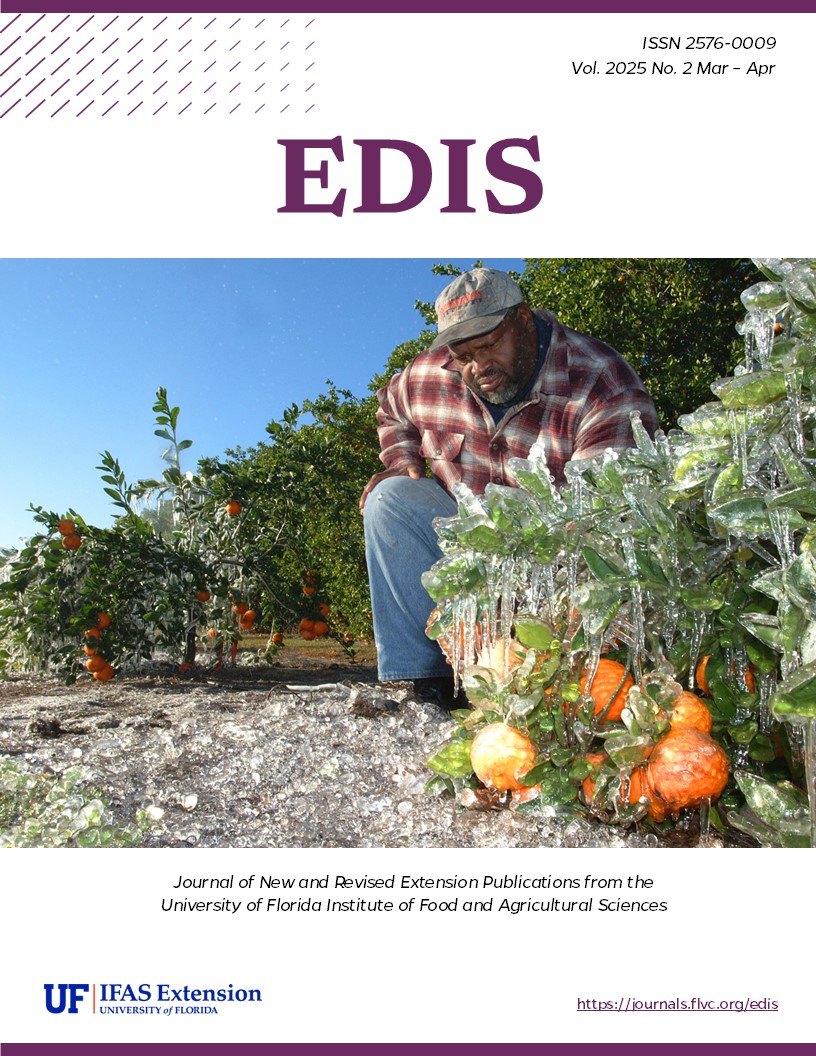Abstract
Increasing public awareness of the dangers of declines in biodiversity has generated unprecedented interest in promoting beneficial insects and other wildlife in yards and gardens. Research shows that well-managed urban landscapes can support diverse wildlife and that many people want their yards to support insect conservation. The green industry has made efforts to align plant production practices, marketing, and landscape maintenance with consumer conservation goals. However, backyard conservation efforts can be hindered by insect pest outbreaks. These are often more frequent and severe in urban landscapes than in rural or natural areas because of environmental constraints. Invasive pest species may thrive unchecked and require intervention. People may face difficult decisions when trying to balance conservation goals with pest management and plant health needs. This publication explains the ornamental plant pest management process with an emphasis on protecting beneficial wildlife.
References
Asano, S. I., C. Yamashita, T. Iizuka, et al. 2003. “A Strain of Bacillus thuringiensis Subsp. galleriae Containing a Novel cry8 Gene Highly Toxic to Anomala cuprea (Coleoptera: Scarabaeidae).” Biological Control 28 (2): 191–6. https://doi.org/10.1016/S1049-9644(03)00060-4
Baldock, K. C., M. A. Goddard, D. M. Hicks, et al. 2015. “Where is the UK's pollinator biodiversity? The importance of urban areas for flower-visiting insects.” Proceedings of the Royal Society B Biological Sciences 282:20142849. https://doi.org/10.1098/rspb.2014.2849
Dale, A. G., and S. D. Frank. 2018. “Urban plants and climate drive unique arthropod interactions with unpredictable consequences.” Current Opinion in Insect Science 29:27–33. https://doi.org/10.1016/j.cois.2018.06.001
Frank, S. D., and J. F. Tooker. “Neonicotinoids pose undocumented threats to food webs.” 2020. Proceedings of the National Academy of Sciences 117 (37): 22609–22613. https://doi.org/10.1073/pnas.2017221117
Hall, D. M., G. R. Camilo, R. K. Tonietto, et al. 2017. “The City as a Refuge for Insect Pollinators.” Conservation Biology 31 (1): 24–29. https://doi.org/10.1111/cobi.12840
Harrewijn, P., and H. Kayser. 1997. “Pymetrozine, a Fast‐Acting and Selective Inhibitor of Aphid Feeding. In‐situ Studies with Electronic Monitoring of Feeding Behaviour.” Pesticide Science 49 (2): 130–40. https://doi.org/10.1002/(SICI)1096-9063(199702)49:2<130::AID-PS509>3.0.CO;2-U
Khachatryan, H., and A. Rihn. 2020. Khachatryan, Hayk, and Alicia Rihn. 2020. “Are Consumers Interested in Ornamental Plants That Benefit Pollinator Insects? FE997 FE997, 10 2016.” EDIS 2016 (8). Gainesville, FL:5. https://doi.org/10.32473/edis-fe997-2016.
Krischik, V., M. Rogers, G. Gupta, and A. Varshney. 2015. “Soil-applied imidacloprid translocates to ornamental flowers and reduces survival of adult Coleomegilla aculate, Harmonia axyridis, and Hippodamia convergens lady beetles, and larval Danaus plexippus and Vanessa cardui butterflies.” PLOS ONE 10 (3): e0119133. https://doi.org/10.1371/journal.pone.0119133
Mach, B. M., S. E. Glynn, J. C. Daniels, and A. G. Dale. 2024. “Target and Non-Target Effects of Insecticide Use during Ornamental Milkweed Production.” Environmental Entomology 53 (4): 648–658. https://doi.org/10.1093/ee/nvae056
Phyllom Bioproducts 2024. Product Information. www.beetlegone.com/collections/phylloms-products-are-game-changers.
Raupp, M. J., P. M. Shrewsbury, and D. A. Herms. 2010. “Ecology of Herbivorous Arthropods in Urban Landscapes.” Annual Review of Entomology 55 (1): 19–38. https://doi.org/10.1146/annurev-ento-112408-085351
Redmond, C. T., L. Wallis, M. Geis, R. C. Williamson, and D. A. Potter. 2020. “Strengths and Limitations of Bacillus thuringiensis galleriae for Managing Japanese Beetle (Popillia japonica) Adults and Grubs with Caveats for Cross‐Order Activity to Monarch Butterfly (Danaus plexippus) Larvae.” Pest Management Science 76 (2): 472–479. https://doi.org/10.1002/ps.5532
Somme, L., L. Moquet, M. Quinet M, et al. 2016. “Food in a row: urban trees offer valuable floral resources to pollinating insects.” Urban Ecosystems 19 (3): 1149–1161. https://doi.org/10.1007/s11252-016-0555-z

This work is licensed under a Creative Commons Attribution-NonCommercial-NoDerivatives 4.0 International License.
Copyright (c) 2025 UF/IFAS

